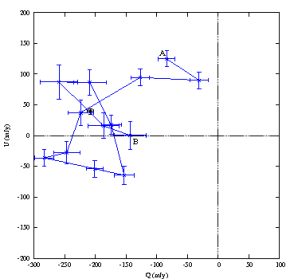|
Small Scale (1", 0.04 pc)
At this resolution the emission from SgrA*, the radio source associated with the black hole in the galactic center, can be isolated from that of the surrounding medium. Thus the temporal, spectral, and polarization properties of SgrA* can be studied even though the instrument resolution is insufficient to resolve it. The SMA was used to make the first extensive measurements of the polarization at 345 GHz with the polarization system that Marrone built for his Ph.D. thesis research. This system uses rotatable quarter-wave plates and a single receiver in each band to allow all four Stokes parameters to be measured. The system was subsequently expanded to include quarter-wave plates at 230 GHz (Marrone 2006 and Marrone and Rao 2008).
Marrone et al. (2007) found that the linear polarization fluctuates on intraday time scales but the rotation measure, derived from the change in position angle of the linear polarization with frequency in the 230 GHz band, stays relatively constant at about -5 x 105 rad m-2 to within a factor of two. This change of the plane of polarization with frequency is attributed to the Faraday rotation effect, which in a cold plasma is proportional to the integral along the line of sight of the product of the longitudinal magnetic field component times the electron density. With detailed modeling of the accretion disk and the assumption of equipartition of energy, a mass accretion rate of about 10-8 M ⊙/year has been be inferred. It is puzzling that this is about five to six orders of magnitude less than the supply rate available from the minispiral based on its mass and lifetime or predicted from X-ray observations. The intraday variability of the linear polarization shows interesting patterns, such as the one depicted in figure 3. Apparent cyclic rotation of the plane of polarization with a period of an hour or two is commonly observed. These patterns may be caused by red (aka 1/ƒ) noise in which the apparent period is about the length of the observation. Alternatively, it could be indicating the orbital period of the gas in the accretion disk (note that the period of the last stable orbit in a non-rotating black hole of 4 x 106 M⊙ is about 30 minutes).
 |
Click here for larger view |
Figure 3: Time sequence of the linear polarization measurements made with the SMA on June 29, 2005, plotted in the Q-U Stokes parameter plane. Note that the origin of the Q-U plot is near the right side of the plot. This display makes it easy to recognize the position angle variations in a source that has a large constant component of polarization. The sequence begins at point A and ends at point B after a duration of about 3.5 hours. The Q-U track appears to orbit the mean polarization (black cross), as might be expected for a synchrotron hot spot orbiting a black hole or in a precessing jet emanating from a black hole. The position angle of the polarization of the variable emission is 0.5 tan-1 q/u, where q and u are the variable parts of the Stokes parameters Q and U . Note that there is no observational evidence for a jet in SgrA* at the present time (Marrone 2006). |
The SMA has participated in many multiwavelength campaigns to attempt to characterize the nature of "flare events" from SgrA*. These campaigns have included, in addition to the SMA, the Chandra X-Ray Telescope, Keck 10-m optical/IR telescope, CSO, the VLA, and other facilities (Eckart et al. 2006, 2009, Marrone et al. 2008, Yusef-Zadeh et al. 2009). The model of an expanding plasmoid, which has the characteristic that the flare appears first at short wavelengths and later at successively longer wavelengths, has achieved some observational support. Although this work requires coordination of major facilities at different wavelengths, it may lead to important insights into the radiation processes of SgrA*.
Muñoz (2009) and Muñoz et al. (2009) systematically studied the response of the SMA polarimeters and determined that the SMA can make reliable circular polarization measurements at levels down to 0.1 percent. The emission from SgrA* was found to be circularly polarized at a level of about 1.5 percent at 230 and 345 GHz, with no significant changes in the sense of polarization or degree from intraday to yearly time scales, based on the few sets of available measurements. Circular polarization is unknown in submillimeter wavelength emission from active galactic nuclei. SgrA* was known to have a small component of circular polarization (about 0.5 percent) in the 1 - 15 GHz frequency range and the increase in circular polarization at higher frequencies may be a clue to its origin. The polarization may be created in the inner part of the accretion disk where relativistic effects are important. Some theoretical calculations suggest that the circular polarization increases sharply toward GHz frequencies (Huang et al. 2008), which could be checked with more sensitive 600 GHz receivers. It is interesting that the theory of Huang and others predicts frequent changes in the sense and degree of circular polarization in the submillimeter band. This prediction is not borne out in our first observations at 230 and 345 GHz.
» Next Page: Ultrasmall scale
« Previous Page
SMA Research
| 

